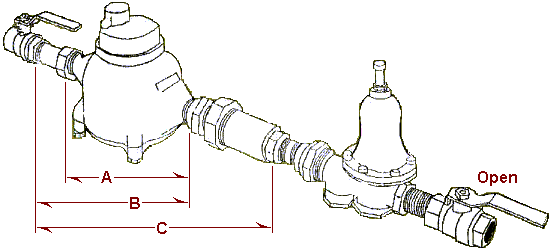Call: 724-337-3577
Office Hours: Mon-Fri 8:00AM – 5:00PM
EMERGENCY (After office hours): 724-335-8595
Frequently Asked Questions
Call 811 Before You Dig!
Do I need to contact anyone before digging with an excavator?

Before you dig, you are required by law to call Pennsylvania One-Call at 811 a minimum of three days before you plan to dig.
They will help you to locate gas, electric and other underground utility lines.

YES! CALL BEFORE YOU DIG: Call: 1-800-242-1776
General Questions
How can I check for a water leak?
Turn off all water using appliances and fixtures. If you have the small leak detection triangle on the dial of your water meter and it is rotating, even slightly, there is water leaking.
If you do not have the detection triangle, observe the dial on your water meter. If this dial is rotating, even slightly, there is water leaking. Or you can read your meter before you go to bed – don’t use any water during the night – and the reading should be the same the first thing in the morning. If it isn’t, you have a leak somewhere in the house. (The meter is read just like the odometer on a car.)
Toilet leaks tend to be less obvious than faucet leaks, but they can waste a significant amount of water if not tended to.
If water is still running into the toilet bowl after it has stopped filling from the flush cycle, or if you can hear water running after the cycle is complete, your toilet is leaking. Most toilet leaks occur at the overflow pipe or at the plunger ball inside the tank. To locate these kinds of leaks, remove the tank lid and flush the toilet. The water level should come to roughly a half-inch below the overflow pipe. Try adjusting the float level control screw so that the valve shuts off the water at the proper level. If the valve itself is leaking you may need to contact a plumber.
Although water may not be seen or heard running, your toilet may have a silent leak.
To test for this, put a few drops of food coloring into the tank, but DO NOT FLUSH. If, after about 10 minutes, traces of the food coloring appear in the toilet bowl, your toilet has a silent leak. The leak is most likely to be in or around the plunger ball or flapper valve at the bottom of the tank.
These leaks are easy to fix with parts available at your home improvement or hardware store.
What part of my water line am I responsible for?
Customers are responsible for the section of waterline from the shut off valve located near the edge of the street (curb stop) up to the water meter. All plumbing after the meter is the customer’s responsibility.
How much is One Cubic Foot of Water?
1 cubic foot of water equals 7.48 gallons of water.
Why are Hydrants Flushed?
Periodically, you will see Authority personnel releasing water from hydrants. Although it may appear to waste water, this process is part of a routine maintenance program necessary to maintain the integrity of the water system and to continue to deliver the highest quality water possible to our customers. Hydrant flushing is necessary to make sure hydrants function properly. Flushing is also done to remove sediment from the pipes to maintain water clarity and quality in the distribution pipes.
When the Authority is flushing in your area you may experience a loss of water, low pressure or may see some discoloration in your water. This is only a temporary condition and normal water service will be restored promptly.
When are Hydrants Flushed
We conduct flushing hydrants and end of line blowoffs during the months of April through November. This is semiannual maintenance work to clear the main lines of sediment and to determine that hydrants are working properly. The flushing will take place, weekdays between the hours of 4:00PM and 8:00AM. You may experience a loss of water, low pressure or may see some discoloration in your water. This is only a temporary condition and normal service will be restored promptly. We are sorry for any inconvenience, and we thank you for your patience. As a matter of law, fire hydrants are to be used only as a protection for the public good. This is codified under the Federal Safe Drinking Water Act, as well as the Homeland Security Act.
Your cooperation in the proper use and maintenance of public fire hydrants will be necessary to keep your community’s safety a priority while keeping our costs reasonable. If you have any questions or need additional information, please contact the Authority’s office.
What is a backflow preventer?
Backflow preventers are mechanical plumbing devices installed in a plumbing system to prevent water from flowing backward in the system. A properly installed, tested, and maintained backflow preventer assembly at the water service entrance to a building or property can reliably prevent a cross connection into the community water system.
Board Meetings
How often are regular board meetings?
 Community Participation
Community Participation
We encourage public interest and participation in our
community’s decisions affecting drinking water.
You are invited to participate in our regular board meetings and voice your concerns about your drinking water.
The board meets the 2nd Monday of every month beginning at 7:00 p.m. at:
The Municipal Authority of the City
of New Kensington Office,
920 Barnes Street,
New Kensington, Pennsylvania.
These meetings are advertised in the Valley News Dispatch.
Signing up for Water
What do I need to sign up for water?
Owner
- Sales agreement, closing papers, or deed signed by both parties
- State issued driver’s license or ID
- Lease signed by both landlord and tenant
- Landlord’s name, phone number and mailing address
- State issued driver’s license or ID
Water Meter Installation
How should my water meter be installed?
When you install a water meter please take the following information into consideration:
| Meter Size | A (Meter Only) | B (With 1 connection) | C (With 1 connection & NKWA backflow) | |
|---|---|---|---|---|
 | 5/8″ (DN 15mm) | 7 1/2″ | 9 1/2″ | 13 5/8″ |
| 3/4″ (DN 20mm) | 9″ (230mm) | 11″ | 15 5/16 | |
| 1″ (DN 25mm) | 10 3/4″ (275mm) | 12 3/4″ | 17 1/2″ |
• Depth of Service – 48″
• Type of Service – K Soft Domestic Copper 3/4″ or 1″
• Length of Service
A. Copper up to 150′
B. Service beyond 150
1. Requires Vault
2. Customer will install Polyethylene Pipe 200 P.S.I. or 250 P.S.I.
3. If pressure exceeds 150 P.S.I. Customer must install pressure reducing valve before meter (330 P.S.I. Rating)
Water Quality
Is fluoride added to my water?
Yes, we maintain a concentration of fluoride in the water between 0.6 to 0.8 ppm.
There is black slime on my faucet where the water comes out. Is there something wrong with my water?
Areas that are routinely damp are prone to mold and bacterial growth. Regular cleaning of these areas with sanitizing cleaners will help prevent these from forming.
Why is There is a pink ring in my pet’s water bowl and in my toilet at the water line as well?
This is caused by an airborne bacteria. Regular cleaning will prevent this from happening.
My water doesn’t smell right. Why does It smell musty/earthy/fishy?
Turn on the water and let it run for a few minutes. If the odor goes away, it’s likely the drain lines that are causing the smell to occur. If the odor is from the hot water alone, it is possible that the cause is a bad magnesium rod in the hot water tank, for which you would need to contact a plumber. If the odor persists after thoroughly cleaning the area and running the water for a while, please contact us.
Water Conservation Tips
Conservation measures you can use inside your home
Here are a few suggestions:Conservation measures you can use inside your home include:
- Fix leaking faucets, pipes, toilets, etc.
- Replace old fixtures; install water-saving devices in faucets, toilets and appliances.
- Wash only full loads of laundry.
- Do not use the toilet for trash disposal. Take shorter showers.
- Do not let the water run while shaving or brushing teeth.
- Soak dishes before washing.
- Run the dishwasher only when full.
Conservation measures you can use outside your home
You can conserve outdoors as well:
- Water the lawn and garden in the early morning or evening.
- Use mulch around plants and shrubs.
- Repair leaks in faucets and hoses.
- Use water-saving nozzles,
- Use water from a bucket to wash your car, and save the hose for rinsing.
Right To Know Policy
Right To Know Policy
This policy sets forth the procedures for requesting access to, or copies of, public records from the MUNICIPAL AUTHORITY OF THE CITY OF NEW KENSINGTON